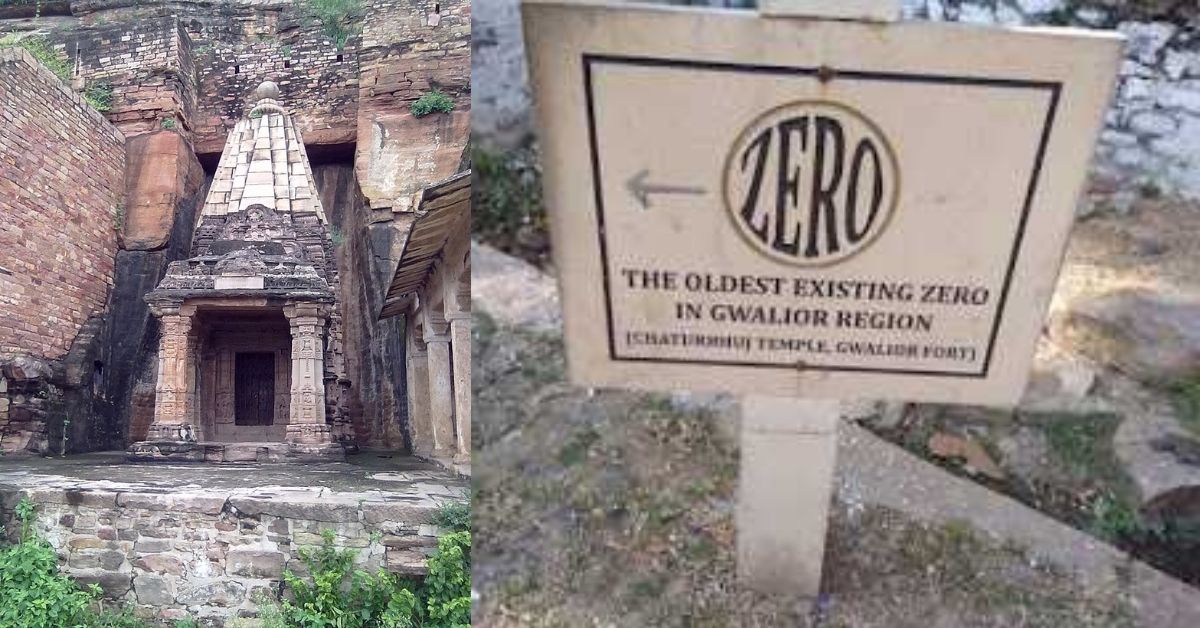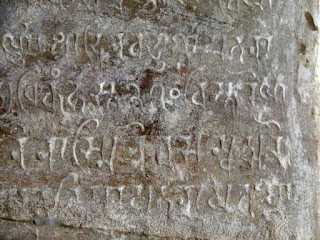World’s ‘Oldest’ Recorded Zero Symbol Is At Gwalior’s Chaturbhuj Temple
Chaturbhuj temple in Gwalior is home to the world’s oldest recorded symbol of zero. Here’s the fascinating story of ancient India’s link to zero.

Every Indian history aficionado must have visited the cultural hub of Gwalior in the heart of the country. Once reigned by the Rajput dynasty of the Tomars, it was passed on to the Mughal empire under Babur’s rule in the early 16th century. The city was also home to musician and poet Tansen, one of the nine jewels (navratnas) in Akbar’s court. Hence, the Gwalior Gharana is not only one of the oldest Hindustani classical music schools in the country, but also the most revered.
The present-day city, which formed the core of the erstwhile princely state of Gwalior ruled by the Maratha Scindia clan, is best known for the formidable Gwalior Fort. Legend goes that it was named in honour of Hindu saint Gwalipa, who is said to have cured a local chieftain of leprosy. It is also the site where Rani Lakshmibai breathed her last during the Revolt of 1857.
Built atop Gopachal Parvat—the largest of the five clusters of rock-cut Jain monuments from the 15th century—the Gwalior Fort is replete of impressive architectural feats that are reflected in its palaces, temples and some reservoirs. Among the most frequently visited sites here include the Dravidian style Teli-ka-Mandir, the Gujari Mahal, built by Raja Man Singh for his queen Mrignayani; the Man Mandir Palace, built during the Tomar reign but also where Aurangzeb is said to have imprisoned and executed his brother; and the twin-pillared Sas-Bahu temples.
It is the Chaturbhuj temple, however, that has continually piqued the interest of mathematicians from all eras. A plaque dating back to the ninth century on a wall of the temple depicts the circular figure “O”, considered by most to be the oldest recorded symbol of zero as we know and use the digit today.
On the path to the Haathi Pol or Elephant Gate of the Gwalior Fort, the Chaturbhuj temple was built in 876 AD and is dedicated to the Hindu God of Vishnu. Inscriptions on the plaque refer to the number twice; in a grant for a land spread across 270 x 167 hastas—an ancient unit of length measured from the tip of the middle finger to the elbow–as well as another grant of commissioning 50 flower garlands on a daily basis.

As a Dot
For the longest time, the inscription at Chaturbhuj temple was also considered to be the earliest recorded example of the usage of zero. In 1891, however, French archaeologist Adhemard Leclere discovered a dot in a set of script, referring to zero, carved in a sandstone surface at the Trapang Prei archaeological site in northeastern Cambodia’s Kratie province.
“The Chaka era has reached the year 605 on the fifth day of the waning moon,” read the script from the Khmer civilisation, estimated to have originated in 687 AD. In January 2017, the National Museum of Cambodia also included the ancient script in its exhibition, owing to the significance of the numeral system in the construction of temples during the Khmer empire, including the UNESCO World Heritage Site of Angkor Wat complex. [1]
Even as a mere ‘dot symbol’, however, it was an ancient Indian scroll from the third or the fourth century that is said to have contained hundreds of such zeros — arguably their first mention across the world — as per researchers from the Oxford University. [2]
“The creation of zero as a number in its own right, which evolved from the placeholder dot symbol found in the Bakhshali manuscript, was one of the greatest breakthroughs in the history of mathematics,” Marcus du Sautoy, Professor of Mathematics at the University of Oxford, once said.
“We now know that it was as early as the 3rd century that mathematicians in India planted the seed of the idea that would later become so fundamental to the modern world. The findings show how vibrant mathematics has been in the Indian sub-continent for centuries,” he added.
The Bakhshali manuscript was discovered in 1881 at a field in the Indian village of Bakhshali, Mardan (present-day Pakistan). It was Japanese scholar Dr Hayashi Takao who first extensively researched its contents, pegging its origins between the 8th and the 12th century.
His article in the Encyclopedia of the History of Science, Technology and Medicine in Non-Western Cultures revealed that the manuscript held a compilation of mathematical rules and examples from various works. Every rule (sutra) was followed by an example (uddharaṇa), commentary under which included a “statement” (nyasa/sthapana), computation” (karana), and “verification” (pratyaya/pratyanayana). [3]
Later, when the manuscript was brought to the University of Oxford’s Bodleian Libraries in 1902, a research by members of its Heritage Science team determined the scripture’s date by way of carbon dating. They said that the manuscript’s 70 fragile birch leaves, composed from material from three different periods, was the primary reason behind researchers not being able to determine its origins previously.
The Concept of ‘Shunya’
It was in 2013 that British writer Alex Bellows visited the Chaturbhuj temple in Gwalior to undertake research for Nirvana by Numbers, a BBC radio documentary.
Summarising his experiences in an article for The Guardian, he said that it was the Indians who first regarded zero being just as important as the numbers through one and nine, referring to it as “possibly the greatest conceptual leap in the history of mathematics”. While place value strategies were already in use in other civilisations, he wrote, it was in the subcontinent that the number zero was first devised. [4]
As a ‘placeholder’, zero was used to denote the degrees of ranking on the numerical scale. In simple terms, it wouldn’t be worth anything on its own, but would change the value of other numbers on the basis of its positioning. Such systems also describe the case when there is nothing in a position. While the Chinese used a space to represent the same, the Babylonians used a marker, he added.
However, it was an interaction with Renu Jain, a professor of mathematics at Gwalior’s Jiwaji University, that led Alex to opine that Indian philosophy of nirvana—a state of spiritual nothingness—is what led to the mathematical concept of zero.
“Zero denotes nothing. But in India it was derived from the concept of shunya. Shunya means a sort of salvation. When all our desires are nullified, then we go to nirvana or shunya or total salvation,” the professor had told Alex.
In his book The Crest of the Peacock; Non-European Roots of Mathematics, Dr George Gheverghese Joseph, too, wrote that the Sanskrit word for zero, śūnya, meaning ‘void’ or ‘empty’, was combined with the definition of ‘lack’ or ‘deficiency’ in the sacred texts of the Rigveda. The combination resulted in the Buddhist doctrine of emptying one’s mind of impressions and thoughts, or “Śūnyata”.
Meanwhile, Peter Gobets of the Netherlands-based ZerorigIndia Project also agreed that the “numerous so-called ‘cultural antecedents’” in ancient India “make it plausible that the mathematical zero digit was invented there”. [5]
The origins of zero may have been persistently contested, as holding the credit of hailing from a civilisation that discovered zero—leading to the binary system and associated modern technologies—is a significant one. Nonetheless, it is nothing short of fascinating that one of the earliest records of the revolutionary number is within reach to Indians. So while there is much to revel in on a trip to Gwalior, don’t miss out on the chance to experience some cultural pride at the Chatrabhuj temple should you find yourself in the city.
Sources: [1], [2], [3], [4], [5]
This story made me
- 97
- 121
- 89
- 167
Tell Us More
We bring stories straight from the heart of India, to inspire millions and create a wave of impact. Our positive movement is growing bigger everyday, and we would love for you to join it.
Please contribute whatever you can, every little penny helps our team in bringing you more stories that support dreams and spread hope.



















